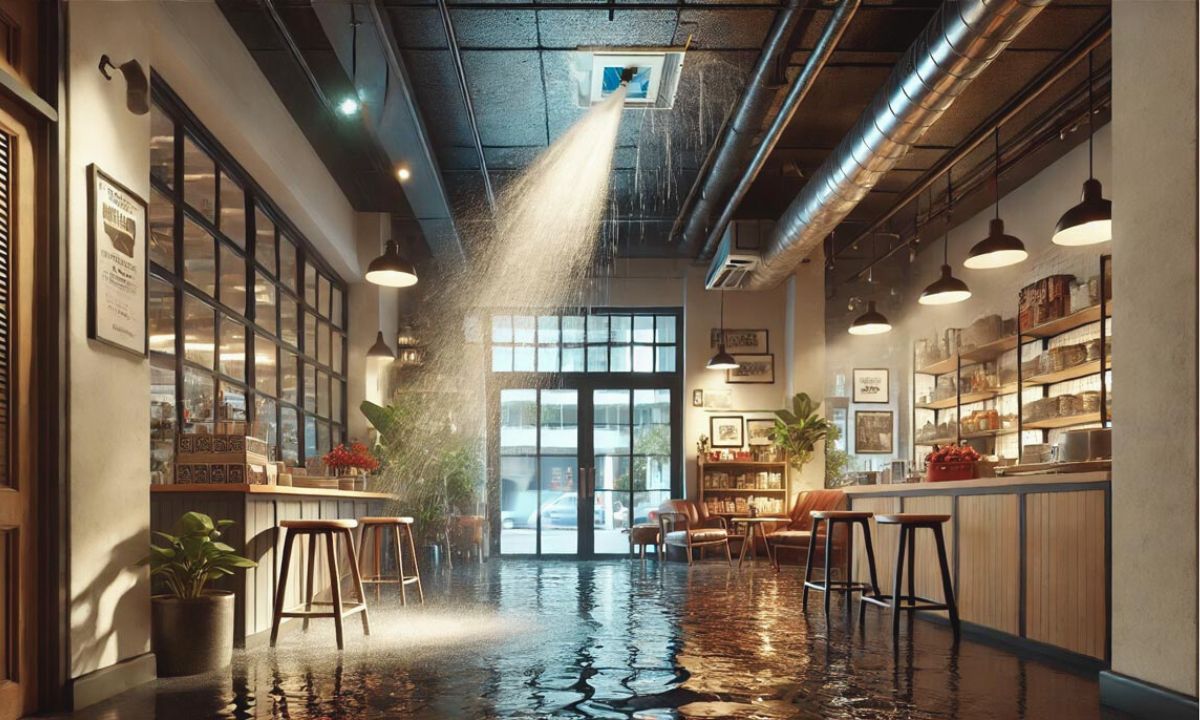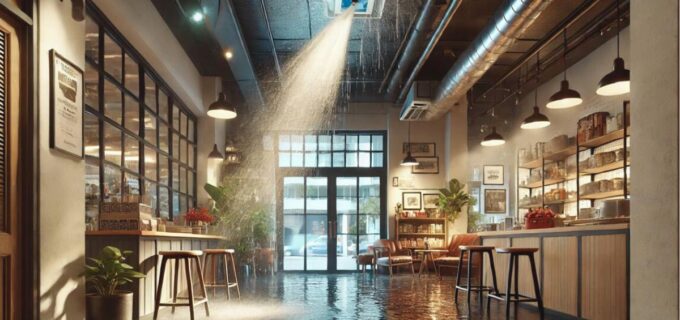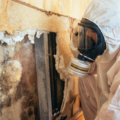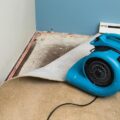
Imagine arriving at your office to find ankle-deep water covering the floor, with valuable equipment and documents submerged. For many Singapore SMEs, this nightmare scenario is an all-too-real possibility. Water damage from burst pipes, heavy rains, or flooding can strike without warning, leaving businesses reeling from its destructive impact. With limited resources and tight profit margins, downtime due to water damage doesn’t just affect the bottom line—it can threaten the business’s survival.
This blog post explores how SMEs can mitigate risks, recover swiftly, and build resilience against water-related disruptions. We’ll explore how advanced drying technologies, proactive measures, and innovative approaches revolutionize how businesses respond to and recover from water-related incidents. From rapid response protocols to integrating smart sensors, we’ll uncover the tools and techniques that are helping SMEs stay one step ahead of potential disasters.
Understanding Water Damage in SMEs
What are the Common Causes of Water Damage?
While water is vital for life, it can also be a formidable destructive force. Water damage can occur at any time and ranks among the most severe threats to any property, causing a multitude of problems, including:
- Warped floors
- Discolored walls
- Mold growth and pest infestations
- Structural weakening over time
Worse, the financial impact of water damage is often deceptive, with even minor flooding resulting in repair costs of tens of thousands of dollars.
Some of the most common causes of water damage include:
- Severe weather: Strong winds and heavy rains can damage roofs, causing leaks. Additionally, flash floods are widespread in Singapore, posing risks, especially to ground-floor properties.
- Clogged Gutters/ Drains: Various debris can obstruct pipes, leading to backups and potential flooding throughout the property.
- Leaking Pipes: Faulty plumbing can damage concrete slabs and walls, promoting mold growth.
- AC Condensation: Most AC units produce condensation in the process of cooling the room down, and this condensation drips down onto a drip pan and is directed out of the property. Damaged or clogged drip pans may cause insulation saturation and damage walls and floors.
- Malfunctioning Sprinklers: Accidental activation can trap excess moisture, resulting in water damage.
What are the Types of Water Damage?
There are three main types of Water Damage:
- Clean Water Damage: This type of water damage originates from sanitary sources like rainwater and poses the least immediate health risk. However, if left untreated, clean water can degrade and become more hazardous over time.
- Gray Water Damage: This category includes slightly contaminated water from washing machines, dishwashers, or toilet overflows (without feces). It may contain microorganisms and organic matter, posing some health risks.
- Black Water Damage: The most hazardous type is black water, which comes from sewage backups or flood water contaminated with organic matter. It harbors harmful bacteria and pathogens and requires immediate and specialized treatment.
How Does Water Damage Affect SMEs?
- Financial Strain: Repair and restoration costs and lost revenue due to business interruptions can significantly strain an SME’s financial resources.
- Operational Disruption: Water damage can disrupt business operations, leading to missed deadlines, supply chain issues, and logistical challenges.
- Employee Productivity: Water damage can negatively affect employee safety, productivity, and morale due to hazardous conditions and a stressful work environment.
- Regulatory and Compliance Issues: Ensuring compliance with health and safety regulations post-water damage can be complex. Additionally, navigating insurance claims and potential legal liabilities adds to the burden on SMEs.
- Reputation Management: Extended business disruptions and visible damage can erode customer trust and negatively impact the business’s brand image.
- Technological and Data Loss: Water damage can significantly damage IT infrastructure, leading to data loss and operational inefficiencies.
- Supply Chain Disruptions: Damage to inventory and storage areas can disrupt supply chains, affecting relationships with vendors and suppliers.
Types of Water Damage Restoration
Efficient Water Extraction and Drying Techniques
Water Damage can significantly threaten businesses in Singapore by potentially causing extensive disruption and financial loss. Fortunately, modern water extraction and drying techniques have revolutionized the restoration process, providing SMEs with a lifeline if faced with this issue.
The most common water extraction methods often used by professionals include:
- Pumping: It works by pumping up water and then eliminating it through a drain or gutter. It comes in several sizes, and if the water level is exceptionally high, a submersible pump may also be used to continuously pump out the water.
- Vacuuming: Used to remove excess water from surfaces like floors, carpets, and other porous areas, industrial wet-dry vacuums work by using a cleaning solution and vacuuming up the moisture. The water is held in a tank. Industrial wet-dry vacuums exceed household vacuums as they can carry more water in their tanks and are used with significant water damage.
These methods supersede household ones, as professionals have access to industrial machinery, which increases their efficiency and ensures thorough water removal, preventing damage.
Advanced Drying Techniques to Prevent Mold Growth
After excess water has been removed, it is crucial to dry the porous areas that have already absorbed the water, including walls and floors. This will prevent mold from growing and the floor from warping.
Some techniques to dry these surfaces include:
Air Movers
- These are powerful, strategically placed fans with the aim to expedite evaporation. This prevents water retention and dries out the surface faster.
- Advantages: Fast and efficient at evaporating water
- Disadvantages: It can be extremely noisy and works best with a dehumidifier, which increases the cost.
Dehumidifiers
- Dehumidifiers draw warm air onto their cold coils through fans. As this moisture collects and condenses, the fan blows the new, dried air out into the room.
- Although the structure may not be exposed, dehumidifiers can extract moisture from inside the walls and below the flooring to thoroughly dry the materials.
- Advantages: helpful to prevent mold growth, can make it easier to breathe
- Disadvantages: It can cause dry cough as it removes the moisture from the air, causing the air to become dry.
Desiccant Drying
- It takes place inside desiccant dehumidifiers. When moist air enters, it passes through a material called desiccant, which absorbs the moisture and holds the water.
- Advantages: effective in all temperatures, allows for thorough drying
- Disadvantages: With increased usage, the desiccant’s performance decreases as it has the maximum amount of water it can retain.
These are just three types of equipment used to dry water and prevent mold growth. Although they can be used separately, they are most efficient when used together. The equipment used to dry water can become extremely costly and, without the right expertise, useless. Hence, it is always important to use professional services to dry your house or office.
Restoration and Repair Strategies
Water damage can cause extensive damage to a building, disrupting business operations. To minimize downtime, it’s crucial to prioritize restoration efforts.
Prioritizing Critical Areas
Focus on restoring areas essential for business continuity first. This includes:
- Essential equipment and machinery: Protecting vital tools and systems allows operations to resume quickly.
- Customer-facing areas: Restoring reception areas, showrooms, and critical customer service points maintains customer trust.
- Health and safety hazards: Addressing immediate safety concerns like electrical hazards or structural instability is paramount.
Structural Repairs and Restoration
Effective restoration involves:
- Drying and dehumidification: Preventing further damage and mold growth.
- Structural stabilization: Ensuring the building’s safety.
- Water extraction: Removing excess water from various surfaces.
- Demolition and removal: Clearing damaged materials for repairs.
- Reconstruction: Rebuilding damaged areas to their original state.
Addressing Mold and Mildew
Mold and mildew can pose health risks. A thorough remediation process includes:
- Mold inspection and testing: Assessing the extent of mold contamination.
- Mold remediation: Involves removing mold-contaminated materials, cleaning surfaces, applying antimicrobial agents, and drying the area to prevent recurrence.
- Air quality testing: Ensuring the environment is safe for occupancy.
Preventative Measures and Future Protection
Implementing Water Damage Prevention Strategies
Proactive measures are crucial in safeguarding your business from water damage. Implementing the following strategies can significantly reduce the risk of costly disruptions.
- Regular Maintenance: Conduct routine plumbing, HVAC systems, and roofing inspections to identify and address potential issues promptly.
- Advanced Detection: Invest in water leak detection systems to provide early warnings of leaks or floods, enabling timely intervention.
- Adequate Drainage: Ensure gutters, downspouts, and drainage systems are clear and functioning optimally to prevent water buildup and infiltration.
- Waterproofing Measures: Protect your property by implementing waterproofing measures in areas susceptible to water damage, such as basements or ground floors.
Combining these preventive measures can create a robust defense against water damage and protect your business’s continuity.
Developing a Water Damage Response Plan
A well-structured water damage response plan is essential for minimizing the impact of an incident. Swift action and coordination are crucial to mitigate losses and restore operations efficiently.
Critical components of a water damage response plan:
- Emergency Contact List: Create a readily accessible list of key contacts, including insurance providers, restoration companies, plumbers, electricians, and other relevant professionals.
- Staff Training and Drills: Equip your staff with the knowledge and skills to respond to water damage incidents. Conduct regular training sessions and drills to familiarise employees with emergency procedures, roles, and evacuation plans.
By implementing these elements, businesses can enhance their preparedness and minimize disruptions caused by water damage.
Water Damage Restoration Case Studies
Tech Startup Overcomes Water Damage
- Client: A rapidly growing IT startup based in East Singapore, Singapore.
- Incident: A burst pipe in the office ceiling caused extensive water damage to the server room, resulting in data loss and equipment failure.
- Challenges: The incident occurred during a critical project deadline, causing significant disruption to operations. Data recovery and restoring the server room to optimal conditions were top priorities.
- Response: The team quickly activated their emergency response plan. They contacted a specialized water damage restoration company, secured temporary office space for employees, and prioritized data recovery efforts. The restoration company used advanced drying techniques and equipment to prevent mold growth and restore the server room to its original condition.
- Outcome: With swift action and expert assistance, they could recover most of their data and minimize business downtime. To prevent future incidents, the company implemented preventative measures, such as installing water leak detectors and conducting regular maintenance checks.
Retail Store Rebounds from Flood
- Client: A popular clothing store in a basement.
- Incident: Heavy rainfall caused flooding in the store, damaging merchandise and fixtures.
- Challenges: The store closed temporarily, leading to lost sales and customer dissatisfaction. Clearing the store of water-damaged items and restoring the premises to a safe and welcoming environment were top priorities.
- Response: They worked closely with their insurance provider and a restoration company to assess the damage and develop a recovery plan. The store implemented a temporary online sales platform to maintain customer engagement and minimize revenue loss. The restoration company used specialized cleaning and drying techniques to restore the store to its original condition.
- Outcome: The team reopened within a week thanks to efficient restoration efforts and a strong focus on customer service. The company learned valuable lessons about flood preparedness and implemented preventive measures to protect its stores in the future.
Choosing the Right Restoration Partner
Essential Qualities to Look For in a Restoration Company
Selecting the right water damage restoration company is crucial for a smooth and efficient recovery. A reputable restoration company possesses several vital qualities:
- Expertise and Experience: Look for a company with a proven track record in handling water damage restoration, particularly in commercial settings.
- Certifications and Licenses: Ensure the company and its technicians have the licenses to operate legally.
- Insurance Coverage: Verify that the company has adequate insurance to protect your interests.
- 24/7 Availability: A reliable restoration company offers emergency services around the clock.
- Customer Reviews and Testimonials: Positive feedback from previous clients strongly indicates a company’s reputation.
The Importance of Commercial Restoration Experience
Choosing a restoration company with experience in commercial settings is crucial. Commercial properties have unique requirements compared to residential properties. A company specializing in commercial restoration understands the specific challenges and can provide tailored solutions to minimize business disruption.
Ensure Business Continuity with Expert Water Damage Restoration for Singapore SMEs
Water damage can be a significant setback for any Singapore SME, but with the right approach, minimizing downtime and restoring business operations efficiently is possible. By implementing preventive measures, developing a comprehensive response plan, and partnering with a qualified restoration company, businesses can protect themselves from the devastating effects of water damage.
Remember, early detection and swift action are crucial to mitigating losses. Understanding your insurance coverage and working closely with your insurer can also streamline recovery.
Choosing a restoration company with experience in commercial settings is crucial. Commercial properties have unique requirements compared to residential properties. A company specializing in commercial restoration understands the specific challenges and can provide tailored solutions to minimize business disruption.
Following the guidelines outlined in this blog, Singapore SMEs can enhance their resilience to water damage and ensure business continuity in the face of unforeseen challenges.
Don’t let water damage disrupt your business operations. Contact Big Red Singapore today, the leading water damage restoration experts, for a consultation and quote. Call us at 6241 9443 or send a WhatsApp message to +65 9222 9222, and let Big Red Singapore help you restore your commercial property swiftly and efficiently, ensuring minimal downtime.




